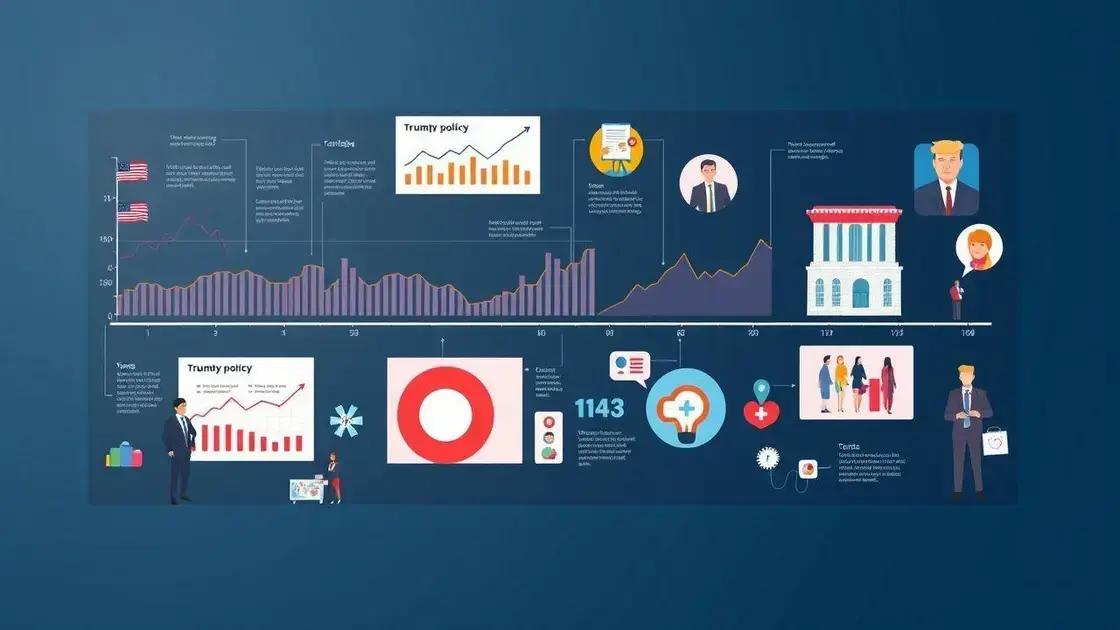Polls reveal shifting public opinion against Trump’s policy proposals

Polls reveal shifting public opinion against Trump’s policy proposals, driven by changing demographics, economic factors, and the influence of social movements advocating for progressive changes.
Polls reveal shifting public opinion against Trump’s policy proposals as voters reassess their stances. Why are attitudes changing so rapidly? Let’s dive into the factors at play.
Recent trends in public opinion
Understanding the recent trends in public opinion is crucial to grasp how Americans see political landscape changes. Various polls showcase how sentiments shift and what influences those changes. People are becoming increasingly aware of policies that affect their everyday lives and voting behavior.
Public Sentiment Shifts
Many factors play a role in altering public opinion. Economic conditions, social movements, and media narratives can all influence how people feel about policies. Recently, there has been a noticeable shift towards more progressive views on various issues, including healthcare and immigration.
- Increased awareness of social justice issues.
- Economic challenges heightening the demand for change.
- Media coverage influences perceptions dramatically.
As voters reflect on these influences, they are reevaluating support for past policies. These reconsiderations can lead to significant electoral consequences. For instance, many voters are now prioritizing environmental policies, showing a shift in the political agenda.
Impact of Demographic Changes
Demographic shifts are also key to understanding trends in public opinion. Younger generations tend to favor progressive policies compared to older voters. This generational gap is reshaping political dialogues and party platforms.
- Higher engagement in voting among younger populations.
- A growing emphasis on climate change and social policies.
- Changing attitudes towards immigration and diversity.
These trends suggest that the political climate is evolving, driven by a new generation of voters. As polls continue to indicate shifting sentiments, parties must adapt to maintain support. This ongoing evolution highlights the dynamic nature of public opinion.
Key issues driving public sentiment
There are several key issues driving public sentiment today. These issues reflect the concerns and priorities of the American people and can influence voting behaviors significantly. Understanding these factors is essential for grasping the political landscape.
Economic Concerns
The economy remains a top priority for many voters. Economic uncertainty affects decisions on spending, jobs, and overall quality of life. With inflation rising and job security fluctuating, people are more focused on financial stability than ever before.
- Rising costs of living impacting household budgets.
- Concerns over job availability in various sectors.
- Demand for better wages and benefits.
As economic conditions change, so does public opinion regarding policies that address these challenges.
Social Issues
Another significant factor is the growing awareness of social justice issues. Movements advocating for equality and inclusion are gaining momentum. Voters are increasingly considering how policies align with their values related to race, gender, and LGBTQ+ rights.
- Heightened advocacy for police reform and racial equity.
- Rising support for women’s rights and reproductive health.
- Increased recognition of LGBTQ+ issues in policy discussions.
This shift demonstrates how societal values can reshape public opinion and influence political priorities.
Environmental Awareness
Environmental concerns are at the forefront of many voters’ minds. Climate change and its effects have become critical issues that demand immediate attention. The growing urgency around environmental policies is leading people to prioritize candidates who advocate for sustainability.
- Interest in green energy and sustainable practices.
- Public demand for action on climate change legislation.
- Awareness of environmental justice and its implications.
As voters align with candidates that prioritize these pressing issues, the influence of environmental matters on public sentiment continues to rise.
Comparison of Trump’s policies over time

Analyzing the comparison of Trump’s policies over time reveals significant changes that have influenced public perception. Throughout his presidency, his approach to various policies has evolved, impacting voter sentiment and policy outcomes.
Early Presidency Policies
At the start of his presidency, Trump focused heavily on immigration and tax reform. His administration implemented strict immigration policies, aiming to restrict entry and promote a ‘merit-based’ system. Alongside these policies, the Tax Cuts and Jobs Act of 2017 reduced corporate tax rates, which was aimed at stimulating economic growth.
- Travel bans on several countries.
- Increased border security measures.
- Corporate tax cuts aimed at boosting investment.
These actions were met with mixed reactions. Supporters viewed them as necessary for national security and economic expansion, while critics argued they were harmful to vulnerable communities.
Mid-Presidency Adjustments
As Trump moved into his second year, the focus shifted. The administration began addressing healthcare and trade wars. His attempt to repeal the Affordable Care Act faced significant pushback. At the same time, tariffs were imposed on various imports, aiming to protect American jobs but leading to concerns over rising consumer prices.
- Ongoing efforts to dismantle the Affordable Care Act.
- Tariffs on Chinese goods triggering international trade tensions.
- Focus on renegotiating trade agreements.
This change in focus highlighted a strategy to solidify his base by appealing to voters concerned about job security and healthcare costs.
Later Policies and Election Campaigns
In the lead-up to the 2020 election, Trump’s policies became increasingly focused on law and order, responding to civil unrest and the COVID-19 pandemic. His administration emphasized a strong stance against protests and aimed to portray strength in handling the pandemic. This shift reflected a desire to appeal to traditional law-and-order voters.
- Criticism of protests and calls for increased policing.
- Efforts to expedite vaccine development through Operation Warp Speed.
- Focus on economic recovery post-pandemic.
Over time, these changes illustrate how Trump’s policies adapted to address the immediate concerns of the electorate, showcasing a dynamic approach in response to public sentiment and current events.
Voter demographics and their impact
The voter demographics play a crucial role in shaping election outcomes and influencing public opinion. Different groups within the population have unique perspectives and priorities, which impact their voting choices and the larger political landscape.
Age and Voting Behavior
Age is a significant factor in voter demographics. Younger voters tend to lean towards progressive policies, while older generations often favor conservative approaches. This age divide influences the types of issues that candidates prioritize
- Young voters are more likely to support climate change initiatives.
- Older voters often prioritize Social Security and healthcare.
- Differences in technology usage can affect campaign outreach and engagement.
These distinctions can shift the focus of campaigns, targeting issues that resonate more with specific age groups.
Race and Ethnicity
Race and ethnicity also impact voting behavior significantly. Diverse communities often face different challenges and have varying political priorities. For instance, minority voters may prioritize issues like equal rights, immigration reform, and education.
- Hispanic voters frequently highlight immigration and economic opportunities.
- Black voters emphasize social justice and criminal justice reform.
- AAPI communities focus on representation and anti-discrimination efforts.
Campaigns that acknowledge and address these specific concerns can effectively mobilize support from these groups.
Geographic Influence
Geographic location can shape voter attitudes and preferences as well. Rural and urban voters often have different needs and perspectives on issues such as healthcare, education, and infrastructure. Urban voters may prioritize public transportation and housing, whereas rural communities often focus on agricultural policies and local economies.
- Urban areas may support more progressive social policies.
- Rural areas tend to favor policies that protect local industries.
- Regional issues significantly influence voter turnout and engagement.
Understanding these geographic differences is vital for candidates looking to connect with and mobilize voters.
Predictions for future polling results
Making predictions for future polling results involves analyzing trends and understanding the factors that influence voter behavior. As public opinion shifts, it’s essential to consider various elements that may shape upcoming elections.
Changing Demographics
One critical factor is the changing demographics of the electorate. Younger voters are becoming a more significant part of the voting population, and their priorities often differ from older generations. This trend indicates a potential shift towards progressive issues, such as climate change and social justice.
- Younger voters favor environmental policies.
- Increased engagement among minority groups.
- Impacts of education on voting preferences.
These changes could lead to different outcomes in future elections, with candidates appealing more to these emerging voter concerns.
Impact of Economic Conditions
Economic conditions also play a crucial role in shaping public sentiment. If the economy continues to recover, voters may favor candidates promoting growth and stability. Conversely, economic downturns could result in increased support for more progressive policies that focus on social safety nets.
- Voter response to inflation and job availability.
- Support for policies addressing economic inequality.
- Perception of government response to economic challenges.
Analyzing economic indicators provides insight into how voters might respond to candidates’ platforms in upcoming polls.
Social Movements and Activism
Social movements and activism significantly influence public opinion. Organizing efforts around issues like racial justice and women’s rights can engage more voters and sway opinions. Active participation in these movements leads to increased awareness and urgency surrounding specific political issues.
- Protests and advocacy can shift political agendas.
- Increased voter turnout linked to social movements.
- Mobilization of groups advocating for change.
As these movements grow, they may affect polling results by prioritizing progressive candidates who reflect the values of active constituents.
In conclusion, understanding the shifting public opinion against Trump’s policy proposals is vital for grasping current political dynamics. The factors influencing this shift are diverse, ranging from changing demographics to economic conditions. As the nation evolves, so do the priorities and concerns of voters. Keeping an eye on these trends will help predict future election outcomes and the impact on candidates’ platforms. Engaging with active social movements is another important aspect that can reshape political conversations. Overall, the landscape of public opinion continues to change, reflecting the values and needs of the electorate.
FAQ – Frequently Asked Questions about Shifting Public Opinion
What factors are causing shifts in public opinion against Trump’s policies?
Shifts are influenced by changing demographics, economic conditions, and the impact of social movements advocating for progressive changes.
How do younger voters influence election outcomes?
Younger voters tend to favor progressive issues like climate change and social justice, affecting candidate priorities and electoral dynamics.
What role does economic performance play in voting behavior?
Economic stability can enhance support for certain policies, while downturns may lead voters to seek more progressive solutions for safety and welfare.
Why are social movements important in shaping public sentiment?
Social movements engage voters around critical issues, increase awareness, and can mobilize support for candidates who align with their values.






